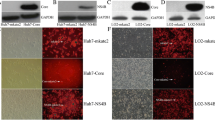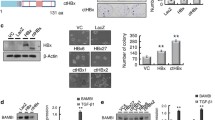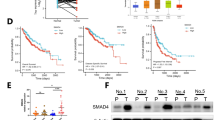Abstract
The core protein of hepatitis C virus (HCV) has been implicated in HCV-induced liver pathogenesis. Previous data have shown that the HCV core protein has pleiotropic functions, including transcriptional regulation of a number of cellular genes, although the mechanism of gene regulation remains unclear. Wnt/β-catenin signaling is also involved in hepatocellular carcinoma (HCC) tumorigenesis. To elucidate the molecular mechanism of HCV pathogenesis, we examined whether HCV core protein activates Wnt/β-catenin signaling in the hepatoma cell line SMMC-7721. The effects of core protein on Wnt/β-catenin signaling cascades were investigated by luciferase reporter gene assay, immunofluorescence, western blot and RT-PCR analysis. Here, we demonstrate that HCV core protein plays an essential role in activating β-catenin/Tcf-4-dependent transcriptional activity and increases active β-catenin expression and nuclear accumulation in SMMC-7721 cells. An RT-PCR assay indicated that core protein upregulates gene expression of canonical Wnt ligands, such as Wnt2, Wnt3, Wnt3a, Wnt8b, Wnt10a, Wnt10b, frizzled receptors Fzd1, 2, 5, 6, 7, 9, and LRP5/6 co-receptors. However, Wnt antagonists SFRP3, 5 and Dkk1 were moderately repressed. Furthermore, ectopic expression of core protein markedly promoted cell proliferation. The soluble Fzd molecule FrzB or the β-catenin inhibitor siBC efficiently blocked cell growth stimulation by the core gene. Our present findings demonstrate that the HCV core protein activates canonical Wnt signaling through tight regulation of several important molecules upstream of β-catenin and presumably results in promotion of cell proliferation in the SMMC-7721 cell line. Taken together, these data suggested that the core protein may be directly involved in Wnt/β-catenin-mediated liver pathogenesis.




Similar content being viewed by others
Change history
04 November 2021
A Correction to this paper has been published: https://doi.org/10.1007/s00705-021-05275-9
References
Alter HJ (1995) To C or not to C: these are the questions. Blood 85:1681–1695
WHO (1997) Hepatitis C: global prevalence. Wkly Epidemiol Rec 72:341–348
Georgel P, Schuster C, Zeisel MB, Stoll-Keller F, Berg T, Bahram S, Baumert TF (2010) Virus-host interactions in hepatitis C virus infection: implications for molecular pathogenesis and antiviral strategies. Trends Mol Med 16(6):277–286
Drazan KE (2000) Molecular biology of hepatitis-C infection. Liver Transpl 6:396–406
Kang SM, Choi JK, Kim SJ, Kim JH, Ahn DG, Oh JW (2009) Regulation of hepatitis C virus replication by the core protein through its interaction with viral RNA polymerase. Biochem Biophys Res Commun 386:55–59
Masaki T, Suzuki R, Murakami K, Aizaki H, Ishii K, Murayama A, Date T, Matsuura Y, Miyamura T, Wakita T, Suzuki T (2008) Interaction of hepatitis C virus nonstructural protein 5A with core protein is critical for the production of infectious virus particles. J Virol 82:7964–7976
Majeau N, Fromentin R, Savard C, Duval M, Tremblay MJ, Leclerc D (2009) Palmitoylation of hepatitis C virus core protein is important for virion production. J Biol Chem 284(49):33915–33925
Joo M, Hahn YS, Kwon M, Sadikot RT, Blackwell TS, Christman JW (2005) Hepatitis C virus core protein suppresses NF-kappaB activation and cyclooxygenase-2 expression by direct interaction with IkappaB kinase beta. J Virol 79(12):7648–7657
Cho J, Baek W, Yang S, Chang J, Sung YC, Suh M (2001) HCV core protein modulates Rb pathway through pRb down-regulation and E2F-1 up-regulation. Biochim Biophys Acta 1538(1):59–66
Kao CF, Chen SY, Chen JY, Wu Lee YH (2004) Modulation of p53 transcription regulatory activity and post-translational modification by hepatitis C virus core protein. Oncogene 23(14):2472–2483
Battaglia S, Benzoubir N, Nobilet S, Charneau P, Samuel D, Zignego AL, Atfi A, Bre′chot C, Bourgeade MF (2009) Liver cancer-derived hepatitis C virus core proteins shift TGF-Beta responses from tumor suppression to epithelial-mesenchymal transition. PLoS One 4:e4355
Ariumi Y, Kuroki M, Abe K, Dansako H, Ikeda M, Wakita T, Kato N (2007) DDX3 DEAD-box RNA helicase is required for hepatitis C virus RNA replication. J Virol 81(24):13922–13926
Yoshida T, Hanada T, Tokuhisa T, Kosai K, Sata M, Kohara M, Yoshimura A (2002) Activation of STAT3 by the hepatitis C virus core protein leads to cellular transformation. J Exp Med 196:641–654
Banerjee S, Saito K, Goughoulte MA, Meyer K, Ray RB, Rayet R (2008) Hepatitis C virus core protein upregulates serine phosphorylation of insulin receptor substrate-1 and impairs the downstream Akt/protein kinase b signaling pathway for insulin resistance. J Virol 82:2606–2612
Yuzugullu H, Benhaj K, Ozturk N, Senturk S, Celik E, Toylu A, Tasdemir N, Yilmaz M, Erdal E, Akcali KC, Atabey N, Ozturket M (2009) Canonical Wnt signaling is antagonized by noncanonical Wnt5a in hepatocellular carcinoma cells. Mol Cancer 8:90
Clevers H (2006) Wnt/beta-catenin signaling in development and disease. Cell 127:469–480
Herbst A, Kolligs FT (2007) Wnt signaling as a therapeutic target for cancer. Methods Mol Biol 361:63–91
He TC, Sparks AB, Rago C, Hermeking H, Zawel L, da Costa LT, Morin PJ, Vogelstein B, Kinzler KW (1998) Identification of c-MYC as a target of the APC pathway. Science 281:1509–1512
Tetsu O, McCormick F (1999) Beta-catenin regulates expression of cyclin D1 in colon carcinoma cells. Nature 398(6726):422–426
Zhang T, Otevrel T, Gao Z, Gao Z, Ehrlich SM, Fields JZ, Boman BM (2001) Evidence that APC regulates survivin expression: a possible mechanism contributing to the stem cell origin of colon cancer. Cancer Res 61(24):8664–8667
Bi Y, Huang JY, He Y, Zhu GH, Su YX, He BC, Luo JY, Wang Y, Kang Q, Luo Q, Chen L, Zuo GW, Jiang W, Liu B, Shi Q, Tang M, Zhang BQ, Weng YG, Huang AL, Zhou L, Feng T, Luu HH, Haydon RC, He TC, Tang N (2009) Wnt Antagonist SFRP3 inhibits the differentiation of mouse hepatic progenitor cells. J Cell Biochem 108:295–303
de la Coste A, Romagnol B, Billuart P, Renard CA, Buendia MA, Soubrane O, Fabre M, Chelly J, Beldjord C, Kahn A, Perret C (1998) Somatic mutations of the β-catenin gene are frequent in mouse and human hepatocellular carcinomas. Proc Natl Acad Sci USA 95:8847–8851
Satoh S, Daigo Y, Furukawa Y, Kato T, Miwa N, Nishiwaki T, Kawasoe T, Ishiguro H, Fujitam M, Sasaki Y, Imaoka S, Murata M, Shimano T, Yamaoka Y, Nakamura Y (2000) AXIN1 mutations in hepatocellular carcinomas, and growth suppression in cancer cells by virus-mediated transfer of AXIN1. Nat Gen 24:245–250
Oda H, Imai Y, Nakatsuru Y, Hata J, Ishikawa T (1996) Somatic mutations of the APC gene in sporadic hepatoblastomas. Cancer Res 56:3320–3323
Ban KC, Singh H, Krishnan R, Seow HF (2003) GSK-3β phosphorylation and alteration of β-catenin in hepatocellular carcinoma. Cancer Lett 199:201–208
Miyoshi Y, Iwao K, Nagasawa Y, Aihara T, Sasaki Y, Imaoka S, Murata M, Shimano T, Nakamura Y (1998) Activation of the β-catenin gene in primary hepatocellular carcinomas by somatic alterations involving exon 3. Cancer Res 58:2524–2527
Merle P, de la Monte S, Kim M, Herrmann M, Tanaka S, Von Dem Bussche A, Kem MC, Trepo C, Wands JR (2004) Functional consequences of frizzled-7 receptor overexpression in human hepatocellular carcinoma. Gastroenterology 127:1110–1122
Fukutomi T, Zhou Y, Kawai S, Eguchi H, Wands JR, Li J (2005) Hepatitis C virus core protein stimulates hepatocyte growth: correlation with upregulation of Wnt1 expression. Hepatology 41:1096–1105
Hu YW, Liu CY, Du CM, Zhang J, Wu WQ, Gu ZL (2009) Induction of apoptosis in human hepatocarcinoma SMMC-7721 cells in vitro by flavonoids from Astragalus complanatus. J Ethnopharmacol 123(2):293–301
Li S, Dong P, Wang J, Zhang J, Gu J, Wu X, Wu W, Fei X, Zhang Z, Wang Y, Quan Z, Liu Y (2010) Icariin, a natural flavonol glycoside, induces apoptosis in human hepatoma SMMC-7721 cells via a ROS/JNK-dependent mitochondrial pathway. Cancer Lett 298(2):222–230
Luo JY, Deng ZL, Luo XJ, Tang N, Song WX, Chen J, Sharff AK, Luu HH, Haydon RC, Kinzler WK, Vogelstein B, He TC (2007) A protocol for rapid generation of recombinant adenoviruses using the AdEasy system. Nat Protoc 2(5):1236–1247
Si W, Kang Q, Luu HH, Park JK, Luo Q, Song WX, Jiang W, Luo X, Li X, Yin H, Montag AG, Haydon RC, He TC (2006) CCN1/Cyr61 is regulated by the canonical Wnt signal and plays an important role in Wnt3A-induced osteoblast differentiation of mesenchymal stem cells. Mol Cell Biol 26(8):2955–2964
He TC, Zhou S, da Costa LT, Yu J, Kinzler KW, Vogelstein B (1998) A simplified system for generating recombinant adenoviruses. Proc Natl Acad Sci USA 95(5):2509–2514
Tang N, Song WX, Luo J, Luo X, Chen J, Sharff KA, Bi Y, He BC, Huang JY, Zhu GH, Su YX, Jiang W, Tang M, He Y, Wang Y, Chen L, Zuo GW, Shen J, Pan X, Reid RR, Luu HH, Haydon RC, He TC (2009) BMP-9-induced osteogenic differentiation of mesenchymal progenitors requires functional canonical Wnt/beta-catenin signalling. J Cell Mol Med 13(8B):2448–2464
Castro-Garza J, Barrios-García HB, Cruz-Vega DE, Said-Fernández S, Carranza-Rosales P, Molina-Torres CA, Vera-Cabrera L (2007) Use of a colorimetric assay to measure differences in cytotoxicity of Mycobacterium tuberculosis strains. J Med Microbiol 56(Pt 6):733–737
Longo KA, Kennell JA, Ochocinska MJ, Ross SE, Wright WS, MacDougald OA (2002) Wnt signaling protects 3T3-L1 preadipocytes from apoptosis through induction of insulin-like growth factors. J Biol Chem 277(41):38239–38244
Hou XN, Tan Y, Li ML, Dey SK, Das SK (2004) Canonical Wnt signaling is critical to estrogen-mediated uterine growth. Mol Endocrinol 18(12):3035–3049
Chen L, Wang K, Shao Y, Huang J, Li X, Shan J, Wu D, Zheng JJ (2008) Structural insight into the mechanisms of Wnt signaling antagonism by Dkk. J Biol Chem 283(34):23364–23370
Montgomery E, Torbenson MS, Kaushal M, Fisher C, Abraham SC (2002) Beta-catenin immunohistochemistry separates mesenteric fibromatosis from gastrointestinal stromal tumor and sclerosing mesenteritis. Am J Surg Pathol 26(10):1296–1301
Sakamoto A, Oda Y, Adachi T, Saito T, Tamiya S, Iwamoto Y, Tsuneyoshi M (2002) Beta-catenin accumulation and gene mutation in exon 3 in dedifferentiated liposarcoma and malignant fibrous histiocytoma. Arch Pathol Lab Med 126(9):1071–1078
Haydon RC, Deyrup A, Ishikawa A, Heck R, Jiang W, Zhou L, Feng T, King D, Cheng H, Breyer B, Peabody T, Simon MA, Montag AG, He TC (2002) Cytoplasmic and/or nuclear accumulation of the beta-catenin protein is a frequent event in human osteosarcoma. Int J Cancer 102(4):338–342
MacDonald BT, Tamai K, He X (2009) Wnt/beta-catenin signaling: components, mechanisms, and diseases. Dev Cell 17:9–26
Mukai A, Yamamoto-Hino M, Awano W, Watanabe W, Komada M, Goto S (2010) Balanced ubiquitylation and deubiquitylation of Frizzled regulate cellular responsiveness to Wg/Wnt. EMBO J 29:2114–2125
Monga SPS (2009) Role of Wnt/β-catenin signaling in liver metabolism and cancer. Int J Biochem Cell Biol 3084–3093
Li YH, Lu WY, King TD, Liu CC, Bijur GN, Bu GJ (2010) Dkk1 stabilizes Wnt co-receptor LRP6: implication for Wnt ligand-induced LRP6 down-regulation. PLoS One e11014
Ugolini F, Adélaïde J, Charafe-Jauffret E, Ngugen C, Jacquemier J, Jordan B, Birnbaun D, Pebusque MJ (1999) Differential expression assay of chromosome arm 8p genes identifies frizzled-related (FRP1/FRZB) and fibroblast Growth factor receptor 1 (FGFR1) as candidate breast cancer genes. Oncogene 18:1903–1910
Nagahata T, Shimada T, Harada A, Naga H, Onda M, Yokoyama S, Shiba T, Jin E, Kawanami O, Emi M (2003) Amplification, up-regulation and over-expression of DVL-1, the human counterpart of the Drosophila disheveled gene, in primary breast cancers. Cancer Sci 94:515–518
Merle P, Kim M, Herrmann M, Gupte A, Lefrançois L, Califano S, Trépo C, Tanaka S, Vitvitski L, de la Monte S, Wands JR (2005) Oncogenic role of the frizzled-7/beta-catenin pathway in hepatocellular carcinoma. J Hepatol 43(5):854–862
Terris B, Pineau P, Bregeaud L, Valla D, Belghiti J, Tiollais P, Degott C, Dejean A (1999) Close correlation between beta-catenin gene alterations and nuclear accumulation of the protein in human hepatocellular carcinomas. Oncogene 18(47):6583–6588
Yamanaka T, Kodama T, Doi T (2002) Subcellular localization of HCV core protein regulates its ability for p53 activation and p21 suppression. Biochem Biophys Res Commun 294:528–534
Zakut R, Givol D (1995) The tumor suppression function of p21Waf is contained in its N-terminal half (‘half-WAF’). Oncogene 11:393–395
Acknowledgments
We thank Dr. Jianming Hu of The Pennsylvania State University College of Medicine, USA, for critical reading of the manuscript, Dr. Charles M. Rice of Rockefeller University, USA, for kind provision of plasmid HFL, Dr. T.-C He of University of Chicago, USA, for kind provision of plasmid pTop-luc and adenoviruses expressing Wnt3A, FrzB and siBC. This work was supported by research grants from China National Natural Science Foundation (#30972586, NT), Natural Science Foundation Project of CQ CSTC (2009BA5036, NT), Natural Science Foundation Project of CQMU (NT) and Major National S&T program (2008ZX10001-016, ALH).
Author information
Authors and Affiliations
Corresponding authors
Additional information
J. Liu and Z. Wang contributed equally to this study.
Rights and permissions
About this article
Cite this article
Liu, J., Wang, Z., Tang, J. et al. Hepatitis C virus core protein activates Wnt/β-catenin signaling through multiple regulation of upstream molecules in the SMMC-7721 cell line. Arch Virol 156, 1013–1023 (2011). https://doi.org/10.1007/s00705-011-0943-x
Received:
Accepted:
Published:
Issue Date:
DOI: https://doi.org/10.1007/s00705-011-0943-x




